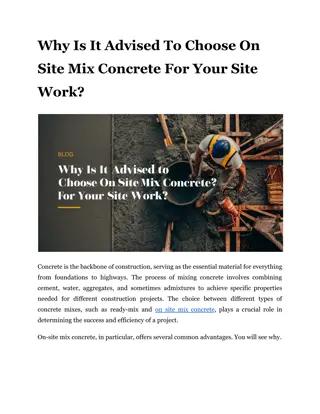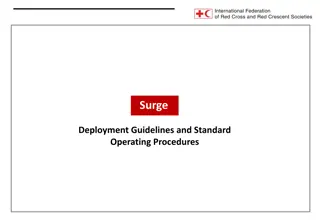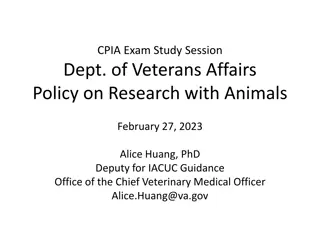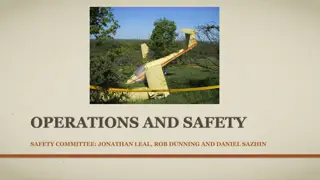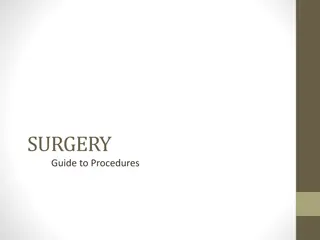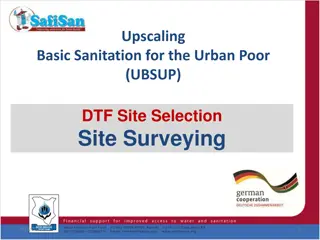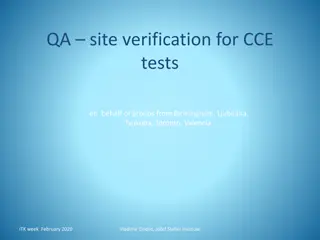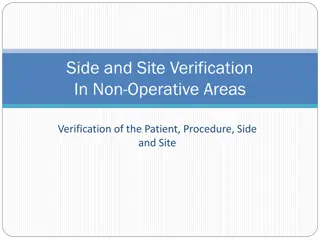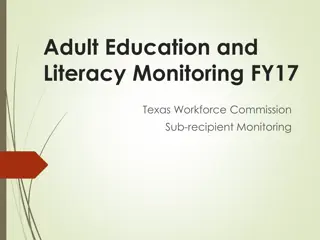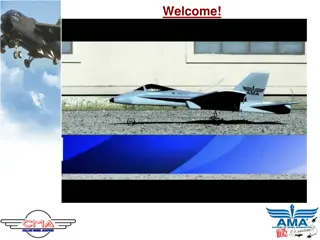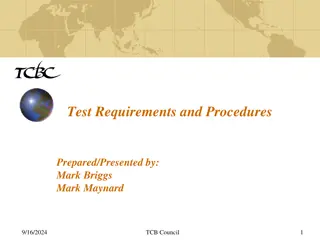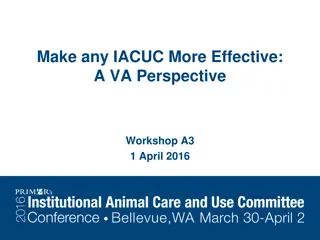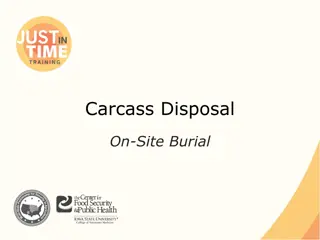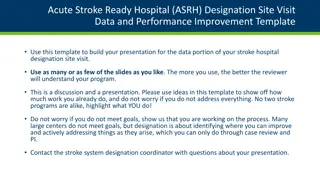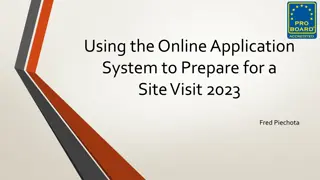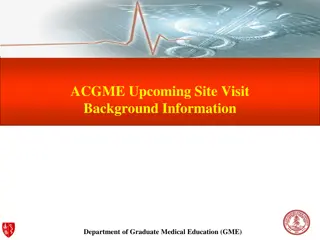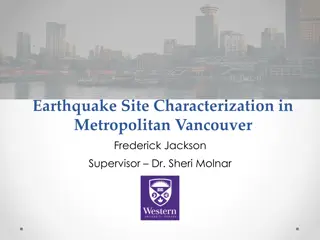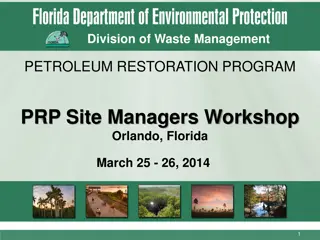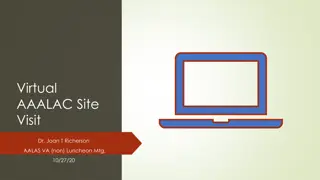AAALAC Site Visit Guidelines and Procedures
AAALAC site visits entail assessments conducted by a team to determine compliance with animal care standards. After the visit, institutions may receive SFIs that are recommendations for improvement or mandatory deficiencies requiring correction. The exit briefing allows for clarification and immediate corrective actions. Institutions can respond with a Post Site Visit Communication (PSVC) within specific timelines. The importance of engaging with the site visit team and understanding the process is emphasized to ensure a successful evaluation.
Download Presentation

Please find below an Image/Link to download the presentation.
The content on the website is provided AS IS for your information and personal use only. It may not be sold, licensed, or shared on other websites without obtaining consent from the author. Download presentation by click this link. If you encounter any issues during the download, it is possible that the publisher has removed the file from their server.
E N D
Presentation Transcript
After the AAALAC site visit Joan T Richerson, DVM Assistant Chief Veterinary Medical Officer Annual AVAVMO and VMU Supervisors Business Luncheon National AALAS, Baltimore, MD 10/30/18
AAALAC terms for deficiencies Mandatory Item = a deficiency which must be corrected for Full Accreditation to be awarded or continued Suggestion for Improvement (SFI) = items which the Council feels are desirable to upgrade an already acceptable or even commendable program
Bear in mind: Your institution is not required to respond to SFIs presented during the exit briefing, although you are free to do so (and also to disagree) through a Post Site Visit Communication (PSVC), which is a written response from your organization back to the Council on Accreditation. An SFI does not automatically become a mandatory item for correction during the next site visit cycle, unless it becomes one of numerous SFIs within the same program area that collectively signal a broader problem with a major element of the animal care and use program.
The Exit Briefing The purpose of this briefing is to provide the unit with preliminary findings and impressions of the site visitors. It also provides the institution an opportunity to correct any misinterpretations or errors in site visitors' observations before the final report is written. If appropriate, the unit is given the opportunity to initiate corrective action of the issues that can be addressed immediately or within ten (10) business days.
PSVC The PSVC should be signed by the Institutional Official (IO) or the official AAALAC International Correspondent (designated to AAALAC by the IO) and received by the AAALAC International Executive Office no later than fourteen (14) calendar days following the conclusion of the site visit. Supplemental correspondence sent subsequent to the initial response must be received no later than 30 calendar days after the site visit and no later than fourteen calendar days prior to the Council meeting. You will be advised of the date of the Council meeting by the Council member leading the site visit.
Site Visit Team The AAALAC site visit team is composed of a Council member and an ad hoc consultant(s). The Council member is the advocate for your institution when Council meets; therefore, it is important that the Council member has a clear understanding of your program. AAALAC encourages the institution to reach out to the Council member, if they have questions or have additional information to share.
Accreditation Status Categories Category Accredited? Max # of months to correct mandatory item(s) N/A Continued Full Accreditation Yes (fully accredited) Conditional Accreditation Yes Correction of a mandatory item(s) to be reported in the next Annual Report or at Council s discretion. 2 months. Failure to correct mandatory item(s) = Probation. Deferred Accreditation Yes
Accreditation Status Categories cont. Category Accredited Max # of months to correct mandatory item(s) Probation Yes Maybe up to a total of 12 months. These are not consecutive calendar months but instead are the number of months granted by Council in each letter to the institution. If adequate corrections of mandatory items are not made within the allotted time, intent to Revoke accreditation will be initiated. Revoke Accreditation Accredited until letter is received N/A Unit has the option to appeal.
VA requirement Per VHA HANDBOOK 1200.07 : All VA animal facilities* and affiliates, or other animal facilities that house animals purchased with VA funds, or used for VA or VA research and education corporation projects must be accredited by AAALAC. * AAALAC accredits programs
Scenario #1 AAALAC site visitors notice what appears to be a small clean glue trap located near an exterior door of the feed room. The site visitors question the VMU Supervisor and the Attending Veterinarian about the use of glue traps. They explain that the glue traps are checked daily, used as a surveillance method for insects and are not used for rodent control. The site visitor makes a note and moves on with the facility review.
Scenario #1- What would you do? a) During the site visit provide documentation to clarify institutional pest control policies and procedures. b) Wait and see if the site visitors bring up the topic of glue traps at the exit interview; if so, provide PSVC within 10 business days addressing this concern. c) The site visitors do not mention glue traps at the exit interview so there is no reason to provide PSVC addressing this glue traps.
Scenario #1 - Analysis a) During the site visit provide documentation to clarify institutional pest control policies and procedures. Best option Address the potential concern ASAP so it is no longer an issue for the site visitors. b) Wait and see if the site visitors bring up the topic of glue traps at the exit interview; if so, provide PSVC within 10 days addressing this concern. Also acceptable but no PSVC would be needed if addressed during site visit. c) The site visitors do not mention glue traps at the exit interview so there is no reason to provide PSVC addressing this glue traps. Risky The site visitors may be pressed for time and fail to mention the glue trap issue and instead focus on more serious concerns. The glue trap issue may be considered an SFI .
Scenario #2 At the exit briefing, the site visitors expressed concern that three out of eight rodent housing rooms have unacceptable temperature excursions and/or inadequate air changes/hr. A review of the room logs indicate that these HVAC issues have been occurring for months and other than being noted in the semiannual facility inspections, no corrective action has been taken. The site visitors indicate that these HVAC issues are likely to be viewed as a mandatory correction by AAALAC Council.
Scenario #2 What would you do? a) Wait and see if AAALAC Council makes the HVAC issues a mandatory correction. b) Submit PSVC detailing a work plan and cost estimate for repairs; start date depends on funding approval. c) Submit PSVC the three rooms were vacated; animals moved to rooms meeting Guide standards. Provide approved PO for parts and Engineering work order for repairs with an estimated completion date.
Scenario #2 - Analysis a) Wait and see if AAALAC Council makes the HVAC issues a mandatory correction. Bad idea - In some cases, Council s decision for Deferred Accreditation vs. Probation may depend heavily on the institution s PSVC. b) Submit PSVC detailing a work plan and cost estimate for repairs; start date depends on funding approval. This response is largely lip service because substantial correction has not occurred. c) Submit PSVC the three rooms were vacated; animals moved to rooms meeting Guide standards. Provide approved PO for parts and Engineering work order for repairs with an estimated completion date. Best strategy Short term and longer-term solutions; may make the difference between Deferred Accreditation and Probation.
Scenario #3: The Hometown VAMC receives the following: Council has reviewed the recent site visit report. The animal care and use program is overall of high quality - features an engaged IACUC and proactive post-approval monitoring program. Council is pleased to inform you that the program generally conforms with AAALAC International standards as set forth by the Guide for the Care and Use of Laboratory Animals, NRC 2011. Therefore Council directs your attention to the Condition listed in the enclosure and requires a written report of actions taken to correct the Condition within one month from the date of this letter (5/1/18) as the criteria for maintaining FULL ACCREDITATION.
Scenario #3: Condition that must be addressed: In Building A Rm 304, a vaccine study involving live influenza A virus challenge in mice was being conducted. The employee health clinic and the VA day-care were also located on the 3rd floor of Building A. The vaccine studies were conducted in a biocontainment suite but the Class II biological safety cabinets (BSC) and the suite s ventilation system had not been evaluated and re-certified since October 2016. Biosafety in Microbiological and Biomedical Laboratories (BMBL) 5thedition requires testing and certification at least annually to safeguard personnel. Council acknowledges receipt of 3/20/18 correspondence that a company specializing in biocontainment facility testing and certification had been consulted; however, Council must be informed when these deficiencies have been addressed.
Scenario #3 -What would you do? a)Nothing because the condition doesn t apply to the Hometown s Veterinary Medical Unit. b)Have the biocontainment suite tested and recertified; notify Council it was completed on 5/22/18 by a third party vendor. c)Complete testing and recertification, send correspondence to Council that includes the third party vendor s report detailing the assessments performed, results, and recertification date.
Scenario #3 - Analysis a)Nothing because the condition doesn t apply to the Hometown s Veterinary Medical Unit. Unacceptable; Council is likely to put the Hometown VAMC on probation. b)Have the biocontainment suite tested and recertified; notify Council it was completed on 5/22/18 by a third party vendor. Better but provides no detail. c)Complete testing and recertification, send correspondence to Council that includes the third party vendor s report detailing the assessments performed, results, and recertification date. Best response The Hometown VAMC has provided documentation that the problems have been definitively resolved within the timeline established by AAALAC.
Scenario #4 Site visitors expressed concern that five out of 12 very large adult rabbits on a long term study had pododermatitis. They mentioned the five rabbits with foot lesions at the exit interview. The VA provided PSVC indicating a SOP for weight management of adult rabbits had been developed. Council acknowledged the PSVC but made rabbits with foot lesions a mandatory correction.
Scenario #4 What would you do? a) Throw up you hands in frustration and swear that AAALAC Council is being picky. b) Send the IACUC-approved SOP on adult rabbit weight management to AAALAC. c) Explain the foot lesions of the five rabbits have healed due to daily treatment, use of resting pad, and weight loss. Provide a weekly log of weights for adult rabbits and a copy of the IACUC-approved SOP on rabbit weight management.
Scenario #4 - Analysis a) Throw up your hands in frustration and swear that AAALAC Council is being picky. Try again. b) Send the IACUC-approved SOP on adult rabbit weight management to AAALAC. Better but lacking. c) Explain the foot lesions of the five rabbits have healed due to daily treatment, use of a resting pad, and weight loss. Provide a weekly log of weights for adult rabbits and a copy of the IACUC- approved SOP on rabbit weight management. Best option This is the only response that confirms the foot lesions have healed, provides an SOP for weight control, and documents rabbit body weights are being monitored.
Take home points: If you can address site visitor concerns during the site visit, do so. Remember the site visitor is the advocate for your institution at Council meetings; provide the information they need. PSVC provided within 10 business days of the site visit is your opportunity to address/resolve concerns before Council meets. Use it! Carefully read Council correspondence and specifically address their directives. Be factual and concise; don t go off on a tangent. Where applicable, indicate WHO is responsible for correction and and WHEN the correction will be made. Document your progress (i.e. updates and completion dates).
Take home points cont. Always respond to Council concerns in a timely manner; do not miss deadlines imposed by AAALAC. Keep the IACUC informed and involved. If a corrective action involves a new policy or standard operating procedure, note the date of IACUC approval. If you are not sure how to respond, please contact the CVMO sooner rather than later.
Resources https://www.aaalac.org/publications/AAALAC_i-brief_SFIs.pdf https://www.aaalac.org/publications/AAALAC_i- brief_Exit_Briefing.pdf https://aaalac.org/members/index.cfm https://aaalac.org/accreditation/categories.cfm https://www.research.va.gov/programs/animal_research/docume nts.cfm#docs-a https://www.cdc.gov/biosafety/publications/bmbl5/


